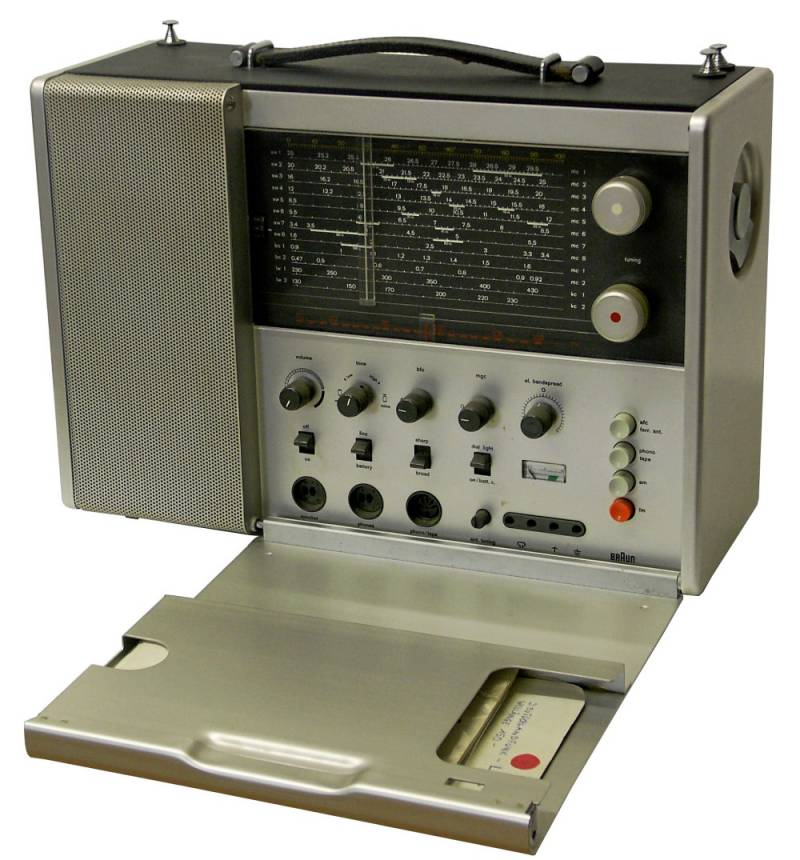Inhaltsverzeichnis
E-623: Braun T1000
Solid state all-wave receiver T1000; made by Braun, Frankfurt.
Universal receiver T1000 ; made by Braun, Frankfurt .
The portable all - wave radio Braun T1000 was acquired in small numbers to serve in the Swiss Army, probably the sets were used by diplomatic staff. The solid state radio was popular among travellers and members of the German diplomatic service, the later version got the designation T1000 CD.
Technical Data
- Frequency range: 130 kHz - 30 MHz (2x LW, 2x MW, 8x SW); 87-108 MHz (FM)
- Analog dial, horizontal, dial accuracy around 25 kHz.
Power Supply
- Mains with optional power supply NT1000: 90 - 130 V, 150 - 240 V
- Accumulator / Batteries: 6 - 12, 24 V; nine mono cells (UM-1)
The receiver is powered by 8 UM-1 1.5 volt batteries, a ninth battery is used for the dial illumination. With the optional TN1000 power pack, the receiver can be operated from mains voltages 90 - 130 or 150 - 240 V, it can also be operated from DC power sources 6 - 12 volts.
Dimensions
- 360 x 235 x 140 mm, 8.5 kg
Accessories
- Standard antenna is the internal ferrite antenna for mediumwaves and the teleskopic antenna for shortwaves.
The T1000 is constructed for stand-alone operation with a ferrite antenna for the long and medium wave ranges, a 1.8 m long telescopic antenna for shortwaves and two VHF telescopic antennas.
- An option for the T1000 was the Peiladapter PV1000 (direction finding adaptor; used for with direction finding with determination of minimum, maximum and side detection, for this the Peilkreuz PK1000 antena is necessary.
Operation
The Braun T1000 is the only reasonable world band radio made by Braun, it came in serveral variants from 1963 to 1970 and was used by embers of the German diplomatic Corps among others.
The radio has a large speaker on the left of the front, and a fold-down cover protects the dials and controls at the right.
A horizontal analog frequency dial is used, the broadcast and amateur radio bands are marked on the dial, but there is no bandspread for the individual bands. One tuning knob is used to tune the AM bands and another for the FM band. The chance of re-tuning a station on a known frequency is quite poor in comparison to receivers with a Wadley loop design or even a digital frequency display like it's today's standards. In order to tune in to a station on a known frequency, the set requires some knowledge of the wave band assignments and recognition of the interval signal.
Below the frequency dial, there is a row of controls: from the left the volume control combined with the main ON/OFF switch, the tone control (by pulling the knob, an AF filter is activated), the BFO control and below it the switch for the two IF bandwidths of +/- 1 and +/- 3 kHz. The control at the right activates the manual gain control MGC, the switch below the dial illumination. This is followed by the fine tuning control, which electronically spreads a small portion of the frequency range tuned with the main tuning (acting like a magnifier lense), just below it in a somewhat awkward position the signal strength meter, which is covered up when a signal is „tweaked“ manually. To the right, there is a vertical row of pushbuttons for AM and FM operation, for tape input and the switchable automatic frequency correction.
In the bottom row there are several jacks (for earphones, line out) and next to the antenna connectors an antenna matching trimmer for the external antenna.
Technical Principle
Technically, theset acts on the AM bands as a single conversion receiver with a RF preamplifier and two tuned RF circuits, the IF is the standard 455 kHz. The IF amplifier has three stages, a semiconductor diode is used for AM demodulation. The AF amplifier comes with a tone control and an audio filter. A BFO is used to receive single sideband and CW broadcasts. The sensitivity is 20 μV in the long-wave range, 15-30 μV in the midediumwaves range and 8 μV on the shortwave ranges.
On the FM band, the receiver has two RF amplifier stages stages, the IF is the typical 10.7 MHz for FM reception. The input sensitivity is 1.4 μV for -26 dB.
The T1000 performs well for the reception of the major international stations; to tune in a station on a known frequency is ver challenging, as the set has no bandspread frequency dial and each shortwave broadcast band is cramped on a few millimeters, the set is much easier tuned on longwaves and mediumwaves. Once a station has been found, fine tuning and narrow LC filters can be used to further optimize reception.
A BFO is provided for CW and SSB reception, tunign in an amateur radio station is even more difficult on a dial without proper bandspread; the set comes with a BFO and manual gain control but the T1000 is definitely not constructed for ECSS reception.
Semiconductors
The radio is completely solid state, 19 transistors, 7 diodes.
Development
In the middle of the sixties, Braun introduced the T1000 with a unique design for a world band radio, with the support of the famous designer Dieter Rams. Its characteristic elements with the large frequency dial and the turret tuner, could be found years later in world band radios of Grundig, Nordmende and other less popular brands.
The mechanical processing and the stability of the set is outstanding. The turret tuner with the gold contacts is still reliable even after decades and the tuning is free of play.
Field use
The role of the Braun T1000 in the Swiss Army is still unknown, the receivers came in a custom made wooden crate with the military designation on it.



